The Spy Who Loved Me (1977)
Directed by: Lewis Gilbert
Written by: Christopher Wood, Richard Maibaum
Starring: Barbara Bach, Curt Jurgens, Richard Kiel, Roger Moore
UK
AVAILABLE ON BLU-RAY AND DVD
RUNNING TIME: 125 min
REVIEWED BY: Dr Lenera, Official HCF Critic
British and Soviet ballistic-missile submarines are mysteriously disappearing and James Bond is summoned to investigate. Meanwhile shipping tycoon and scientist Karl Stromberg kills two scientists who have developed a sophisticated submarine tracking device which has gone missing, and sends two assassins – Jaws and Sandor – to Egypt to find stolen blueprints for the system which are being offered for sale, and to kill anyone who comes into contact with them. James Bond is also sent to Egypt to locate these plans, and encounters Major Anya Amasova – KGB agent Triple X – his rival to recover the microfilm plans, and the girlfriend of a man he killed while on a mission in Switzerland….
The Spy Who Loved Me is Roger Moore’s favourite of his Bonds, and many seem to agree with him, though with all due respect to Roger I wouldn’t quite place it as high as that, even though it certainly doesn’t belong near the bottom. The biggest problem the script writers faced was that Ian Fleming thought his novel about 007 saving a woman from two thugs to be so poor that he wouldn’t allow reprints nor a UK paperback edition while he lived, and he forbade filmmakers from using any of it, even if in actual fact Sol Horror and Sluggsy Morant clearly inspired Jaws and Sandor. However, they could have tried to be a bit more original than coming up with a virtual remake of You Only Live Twice [right down to some almost identical shots] with a great deal of rehashing of bits [particularly From Russia With Love] from other Bond films too. There’s quite a bit that doesn’t make sense either, while its villain is lacklustre, but in most other respects this most glossy-looking of 007 flicks does succeed in providing pretty much everything you could want from one of these films. It also gives Moore’s Bond his best love interest in a Russian spy who’s his equal in nearly every way [well, until she becomes a typical damsel in distress near the end], though as with most of Moore’s other films [Octopussy being the most prominent example], the serious and silly sides of the picture sometimes seem at odds with each other and some of the silly stuff a downright intrusion. It’s still a great show though. This was one of two older Bonds I got to see in a cinema, the other being Live And Let Die, and it really did work great on the big screen.
Stirling Silliphant, John Landis, Ronald Hardy, Anthony Burgess, and Derek Marlowe all worked on the script before Richard Maibaum’s first draft which had an alliance of international terrorists deposing Enrst Stavro Blofeld before trying to destroy the world themselves. Then Kevin McClory [see Thunderball review] popped up again, and with a lawsuit. It said that the script plagiarised a screenplay called Warhead he’d just written for a potential non-Eon Sean Connery Bond film, and that Blofeld and SPECTRE couldn’t be used by Eon. Christopher Wood and an uncredited Tom Mankiewicz aided Maibaum in the final draft. Albert R. Broccoli, now producing on his own, approached Steven Spielberg to direct, who decided to wait to see “how the fish picture turns out”. Veteran Bond helmer Guy Hamilton was asked, but he bailed after being offered Superman, so You Only Live Twice’s Lewis Gilbert was asked. Catherine Deneuve wanted to play the female lead and was willing to cut her normal rate but it was still too high. Shooting took place in Cairo and Luxor [Egypt], Costa Smeralda and Sardinia [Italy], Nassau, Malta, Scotland, Switzerland and Pinewood, where a new stage was built to house the supertanker interior set. It was so big that cinematographer Claude Renoir couldn’t light it due to his deteriorating eyesight. Stanley Kubrick secretly visited the set to tell him how! In Egypt, a food shortage prompted Brocoli to cook spaghetti for the 100-strong crew himself. Jaws’s encounter with a shark was reshot and a shot of him surviving added when Broccoli rightly thought the character would be very popular. So was the film, a major reverse of the slight commercial disappointment of The Man With The Golden Gun.
You Only Live Twice’s spaceship swallowing is rehashed, then we get introduced to General Gogol, the KGB head who will also appear in the next few films, and Soviet agent Anya Amasova. Bond gets involved in an On Her Majesty’s Secret Service-style ski chase where he shoots Anya’s boyfriend, then, in a spectacular bit which was considered for the George Lazenby pic, plummets off a precipice and eventually opens a parachute with the Union Jack on. It just makes you want to cheer, and the whole teaser manages to both work well as a prologue and a set-up for two of the film’s storylines. Maurice Binder’s titles may be his silliest, 007 bouncing around while various miniature, naked women do gymnastics on the barrels of guns. Nobody Does It Better, with Carly Simon beautifully singing Carole Bayer Sayer risqué lyrics [which are obviously about Bond] over a gorgeous Marvin Hamlisch tune, remains one of the great 007 songs even though it’s not obviously ‘Bondish’. We meet our villain very quickly, killing three people [the shark that kills a woman seems to nibble at her crotch], then get back to Bond, really showing what a lady’s man he is, trying to get information out of one woman by making out with her [not seeing a need to slap a face or twist an arm this time] before she’s shot in his arms Thunderball style, and reluctantly accepting an offer to stay in an old friend’s tent when a woman gives him a rose. “When one is in Egypt one should delve deeply into its treasures”, he says, and he may as well have addressed the camera.
We soon get a fabulous sequence set during an evening lecture about the pyramids, where the varying lighting and very dramatic source music cleverly back Jaws killing a man and Bond meeting Anya. The clapping of the audience after Bond has bested Anya’s two helpers is a particularly nice touch. There’s great use of Egyptian locations, and Jaws, biting people like a vampire and bashing one victim against a wall, really is a frightening baddie at first, though the lengthy bit where Jaws [for some reason] drives out to some ruins with Bond and Anya in the back of a van just seems like time wasting, and Bond’s quips about women drivers ruin the excitement of Jaws attacking the two in the van. Saying that, the relationship between Bond and Anya is great as the two are at odds and constantly try to get the better of each other. Eventually they’re ordered to officially team up [’M’ and Moneypenny don’t appear for about 45 minutes though this one has one of the best ‘Q’ lab scenes], and they head for Sardinia – via yet another fight on a train though it’s much better than Moore’s first – and Stromberg’s bizarre base which looks like a water bound Tripod from the old TV series. Of course we know that Anya’s going to find out that Bond killed her boyfriend, and there’s a bit of tension when he does, but the emphasis is on sea-bound action. The mayhem inside the super tanker is great stuff and has an old war movie feel about it, though it begins to drag a little, and Bond’s final encounter with Jaws is both disappointing and stupid when it depends on the use of a huge magnet which for some reason happens hanging above a shark pool. O well, at least Bond gets to shoot Stromberg not once or twice but four times!
The action highlight has Bond and Anya in my personal favourite of all of Bond’s cars – the Lotus Esprit which can go underwater – fend off everything from helicopters to frogmen both on land and beneath the sea. Most – if not quite all – the action is played straight, in what is certainly a faster paced affair than The Man With The Golden Gun, though much of it seems regurgitated, and they can’t decide whether to play some aspects – such as Jaws – straight or for laughs so they alternate awkwardly between the two. Stromberg’s plan makes no sense whatsoever – he wants to destroy the surface and then build himself an underwater kingdom, but surely he doesn’t need to do the former at all, and how on earth is he going to create his Atlantis with no raw materials [or food for that matter?]. On the other hand all those model effects and real explosions in the second half looked great at the cinema and showed up much of the CGI junk we have to put up with today for what it is. Visually The Spy Who Loved Me is a stunner. Claude Renoir’s photography of the locations is lush and Ken Adam’s set designing expertise is at its best. Stromberg’s luxurious living space with its Georgian paintings and slight 70’s-style chic is particularly memorable. And Gilbert brings it all together with skill and slightly faster action directing than in his previous Bond film.
This is the first one where Moore is really relaxed, though I would almost say he’s too relaxed, hardly sleepwalking through the role but not really performing with much conviction and treating much of it as a big lark except for the occasional bits where he has to show a dark side. Obviously many disagree, and he does play some moments well, like when he’s visibly hurt when Anya brings up the fact that his wife was killed. Barbara Bach may be a stunner but can barely seem to act at all, while Curt Jurgens certainly can act but just comes across as a grumpy old man. Caroline Munro has a too-small role as a Fiona Volpe-like character [Bond obviously being attracted to her while Anya smoulders is hilarious] and another Hammer alumni Milton Reid, who auditioned for the role of Oddjob, appears briefly as a heavy. Hamlisch’s score is uneven but rarely actively bad. He writes a great disco version of the Bond theme which is fine backing for some of the action, some lovely underwater music, and a great John Barry-like piece for the supertanker, though many other cues tend to meander, there’re no notable themes except for the main one, and one particular cue from From Russia With Love is shamelessly copied. It’s a shame though that not much of the score is on the soundtrack album. Despite its high reputation, The Spy Who Loved Me feels a little empty to me and spends too much time rehashing past glories, but it’s probably the film most representative of the Moore era and it still never fails to entertain – which is the main thing really.

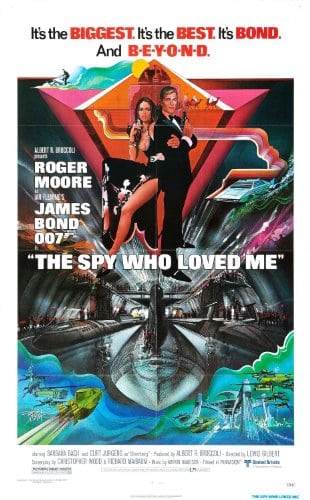
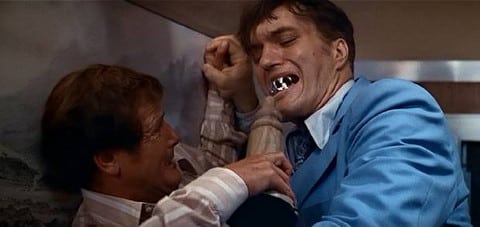
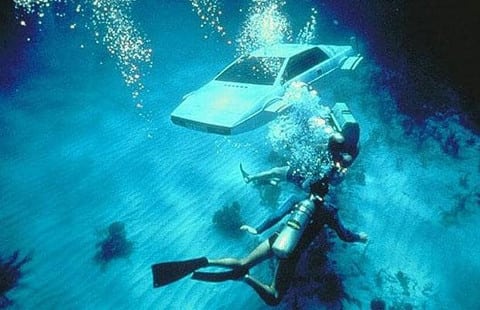




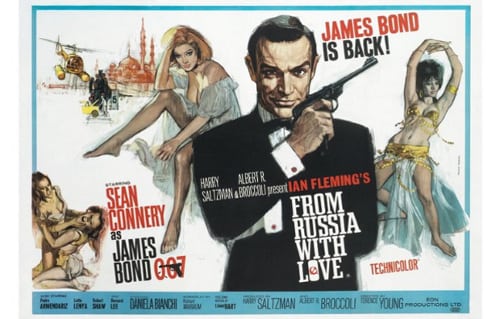

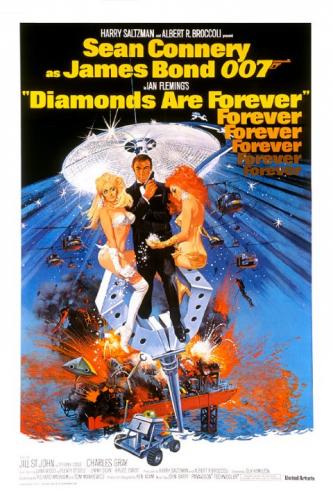
Be the first to comment